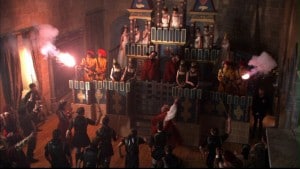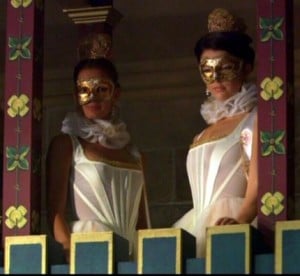
Chronicler Edward Hall records the Château Vert pageant and it sounds like an amazing spectacle. Here is my modernised version of his account:
“On Shrove Tuesday at night, the said Cardinal to the king and ambassadors made another supper, and after supper they came into a great chamber hanged with arras, and there was a cloth of estate, and many branches, and on every branch 32 torchettes of wax, and in the nether end of the same chamber was a castle, in which was a principal tower, in which was a cresset burning: and two other lesser towers stood on every side, warded and embattled, and on every tower was a banner, one banner was of 3 rent (torn) hearts, the other was a lady’s hand gripping a man’s heart, the third banner was a lady’s hand turning a man’s hart: this castle was kept with ladies of strange names, the first Beauty, the second Honour, the third Perseverance, the fourth Kindness, the fifth Constance, the sixth Bounty, the seventh Mercy, and the eighth Pity: these eight ladies had Milan gowns of white satin, every lady had her name embroidered with gold, on their heads cauls, and Milan bonnets of gold, with jewels. Underneath the base fortress of the castle were other eight ladies, whose names were Danger, Disdain, Jealousy, Unkindness, Scorn, Malbouche [evil speaking], Strangeness, these ladies were attired like women of India.
Then entered eight Lords in cloth of gold caps and all, and great mantel cloaks of blue satin, these lords were named Amorous, Nobleness, Youth, Attendance, Loyalty, Pleasure, Gentleness, and Liberty, the king was chief of this company, this company was led by one all in crimson satin with burning flames of gold, called Ardent Desire, which so moved the Ladies to give over the Castle, but Scorn and Disdain said they would hold the place, then Desire said the ladies should be won and came and encouraged the knights, then the lords ran to the castle, (at which time without was shot a great peal of guns) and the ladies defended the castle with Rose water and Comfits and the lords threw in Dates and Oranges, and other fruits made for pleasure but at the last the place was won, but Lady Scorn and her company stubbornly defended them with bows and balls, till they were driven out of the place and fled. Then the lords took the ladies of honour as prisoners by the hands, and brought them down, and danced together very pleasantly, which much pleased the strangers, and when they had danced their fill then all these unmasked themselves and were known: and then was there a costly banquet, and when all was done, the strangers took their leave of the king and the Cardinal and so departed into Flanders, giving to the king much commendation.”1

We know that The King’s sister, Mary Tudor, Queen of France, played Beauty; the Countess of Devonshire played Honour; Jane Parker (later Boleyn) played Constancy; Mary Boleyn played Kindness, Anne Boleyn played Perseverance, and other ladies involved included Mistress Browne and Mistress Danet (probably Elizabeth Danet).2
Showtime’s “The Tudors” TV series depicted Henry VIII falling in love, or rather lust, with Anne Boleyn at this pageant. However, the first actual firm evidence we have of their relationship is Henry VIII’s application to the Pope in August 1527 for a dispensation to marry again and to cover the impediment of “affinity arising from illicit intercourse in whatever degree, even the first”, i.e. to marry a woman who was closely related to someone Henry VIII had previously slept with. You can read the various theories regarding when the couple fell in love in my article Henry VIII Falls in Love with Anne Boleyn.
Two days before this pageant, Henry VIII had ridden out at the Shrovetide joust with the motto Elle mon Coeur a navera or “She has wounded my Heart”, and a picture of a wounded heart embroidered on the trappings of his horse. Henry VIII was followed by Nicholas Carew who wore a motto in French translating to “in prison I am at liberty, and at liberty I am in prison”. Others wore the motto “my heart is between joy and pain” and still others wore “my heart is bound” and “my heart is broken”. Finally, came Anthony Browne with embroidered broken gold hearts and the words, as Hall records them, sance remedy, “without remedy”. Who was this motto aimed at? Who had wounded the king’s heart and why was unrequited love the theme? Some historians believe that Mary Boleyn, Anne’s sister, was the woman who Henry VIII was pursuing at this time, but there really is no way of knowing who the king was wooing with this dramatic display of courtly love. See Mary Boleyn and Henry VIII for more on them.
Today is also the anniversary of the birth of Henry Carey, son of Mary Boleyn, in 1526 – click here to read an article about him.
Notes and Sources
- Hall, Edward (1809) Hall’s chronicle: containing the history of England, during the reign of Henry the Fourth, and the succeeding monarchs, to the end of the reign of Henry the Eighth, in which are particularly described the manners and customs of those periods. Carefully collated with the editions of 1548 and 1550, printed for J. Johnson; F.C. and J. Rivington; T. Payne; Wilkie and Robinson; Longman, Hurst, Rees and Orme; Cadell and Davies; and J. Mawman; London, p630-31.
- Revels 1522, in Revels: Miscellaneous 1519, Letters and Papers, Foreign and Domestic, Henry VIII, Volume 3, 1519-1523, p. 1548-1559.